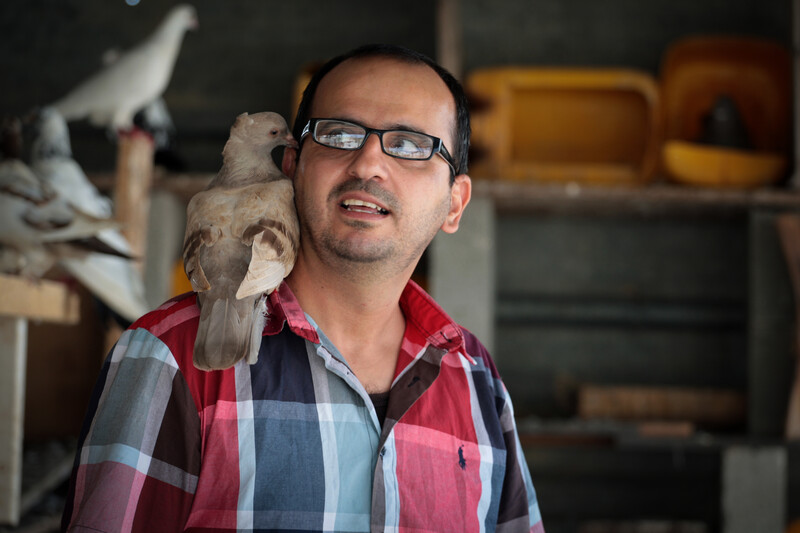The Electronic Intifada 6 July 2015
Countless Palestinians living under Israeli military occupation in the West Bank and Gaza Strip struggle daily as a result of injuries from the army.
Many of them have disabilities which restrict their mobility and access to jobs and a wider community outside of their immediate family. Some are left with a sense of isolation and that they are not valued by society.
According to the Palestinian Centre for Human Rights, approximately 31,000 Palestinians were injured in the West Bank and Gaza from 29 September 2000 to early April 2011.
Last year alone, 11,000 were injured in Gaza, almost entirely during Israel’s 51-day summer onslaught.
Text by The Electronic Intifada. Photos and reportage by West Bank-based photojournalist Mohammad Alhaj.

Mahmoud Habash was injured during an explosion in Balata refugee camp near the West Bank city of Nablus on 25 January 2001. He was working as a driver for the Palestinian security officer Azzam Mizher and the two men, along with Mizher’s bodyguard, were in the car when it exploded. Mizher was killed. Israel denied responsibility at the time, but Habash says that the explosion was caused by a bomb planted in the car by Israel to assassinate Mizher. The bodyguard was maimed. Habash is blind and has hearing impairment as a result of his injuries. His left leg is now four centimeters shorter than his right.

Habash lives with his wife and four daughters, as well as his mother, in Balata camp. Economic conditions are especially difficult after his injury and the cost of living is rising, as are education costs for Habash’s children. The Palestinian Authority gives him and other people injured during the intifadas $425 per month and he collects a reduced pension of $475 per month. It is not possible for him to work or move without someone accompanying and helping him, and public facilities are often not accessible for people with special needs.

Habash is originally from the village of Beit Dajan near Jaffa. The village was destroyed after the conquest of Zionist forces in Palestine in 1948. He wears an elevated left shoe to compensate for the height lost due to his injury.

Ehab Mansour, from Nablus, was injured in Balata refugee camp while working as an emergency medic and responding to a call to evacuate an injured person on 23 February 2006, during a major Israeli incursion. “I heard the sound of a bullet and don’t know what happened after that. I stayed in a coma for about a month and after that I stayed in the hospital for the completion of my treatment,” Mansour said.

Mansour said that when he awoke from his coma, he found himself detained and cuffed to a bed in an Israeli hospital under the guard of armed soldiers.

Mansour has lost mobility in his left leg as a result of his injury. His son’s legs were injured in a car accident. Mansour says that he perceives that he is less valued and receives fewer work opportunities than people without disabilities.

Husam Haifawi, from Iktaba village outside the West Bank town of Tulkarem, was was shot in the shoulder while throwing stones at the invading Israeli army on 5 February 2003. He lost movement in both legs and uses crutches to stand and walk. He raises pigeons on the rooftop of his home, which he rarely leaves.

Haifawi practiced karate before his injury. “There were many difficulties, the most important of which is that I feel that society doesn’t give me worth after the injury,” Haifawi said. He home schools his seven children and feels that they are high achievers because of the amount of attention he gives them. His wife works as an English language teacher in a private school in Tulkarem and her salary supports the family, as well as a modest allowance Haifawi receives from the Palestinian Authority distributed to people injured during the intifada.

Haifawi holds a copy of an Israeli newspaper showing him throwing stones at the Israeli army in his village at the start of the second intifada in 2000.

Ahmad Odeh from Iktaba village was injured returning home from school on 11 November 2002 when he was 17 years old. Odeh says there weren’t clashes in the village at the time when the army suddenly opened fire from a Merkava tank that was 250 meters away from him.

“The bullet hit my neck and exited from the other side,” Odeh says of his injury. “I fell on the ground and wasn’t able to move my body. I remained conscious for a little while and saw that I was on the ground and the Merkava was coming near me. I thought that the tank would run over me. But suddenly I saw a Palestinian woman stop in front of the Merkava and scream at the Israeli soldiers until they stopped. After that I lost consciousness.” The Israeli army banned the ambulance from approaching for about 40 minutes, during which Odeh lost a lot of blood, his family told him later.

It took a long time for Odeh to cope with his injuries. Eventually, he recovered some of his health and married a woman from his village. Ahmad has a difficult time moving around in the city. He says: “Generally society’s interest in me as a disabled person is less than if I was not disabled.” He completed a university degree focusing on social services and works for the Iktaba village municipality.




